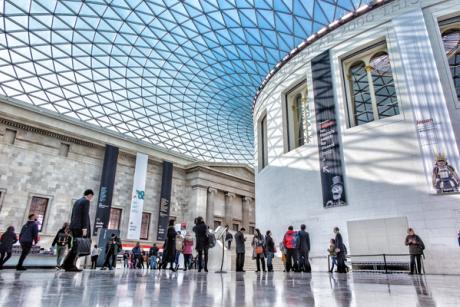
The British Museum’s decision to accept a £50m sponsorship deal with BP caused concern among its trustees, who eventually agreed to accept funding from the energy company despite ethical and safety concerns, as revealed in the minutes of the recently published administrators. The money from BP is to start fundraising for the museum’s ambitious master plan, which would improve the building and re-display the collection.
The Journal of Art can report that one administrator quietly resigned on Nov. 27, and many others have expressed concern. The museum’s security chief has warned that BP’s sponsorship deal could lead to risks for both the collection and staff.
Museum board minutes are usually published shortly after they are approved, which takes place at the next meeting. This was not done and The Journal of Art filed several press requests and a Freedom of Information request for the minutes.
Today (December 19) eight minutes were published simultaneously, for meetings between June and November. “Sensitive” headings, they appear to present a reasonably detailed account of the decisions. The chairman of the board, George Osborne, and the trustees appear to have been quite open about recording their discussions.
The BP deal was first seriously discussed by administrators on June 1. On that occasion, Osborne felt he should be absent from the entire meeting because he declared “a conflict of interest”. BP is a client of Osborne’s investment banking firm, Robey Warshaw, of which he is a partner.
Two of the other 19 trustees indicated their interests. Philipp Hildebrand is vice chairman of BlackRock, which is a major shareholder in BP, although he had no personal conflict of interest. Elizabeth Corley is the chairman of Schroders, which has investments in BP, although not to the extent that this would pose a conflict of interest.
A more detailed discussion took place during the trustees’ meeting on June 29, and Osborne did not participate when the potential BP deal came up for discussion. According to the minutes: “Some trustees expressed strong personal disagreement about the acceptance of money from companies in the sponsor’s line of business, but resolved that these were not such as to require them to recuse themselves from acting as trustees in the decision to be made.”
Charlie Mayfield, who replaced Osborne to chair this part of the meeting, warned that any delay to the master plan (which would benefit from BP funding) will only “increase the risk to safety (people and property) and to revenue due to the the deterioration of the fabric and infrastructure” of parts of the building.
Some trustees “reiterated their personal disagreements with accepting funding from such sponsors,” but nevertheless, “it was unanimously agreed that accepting sponsorship was balanced in the museum’s best interests.”
Discussion of the BP deal was soon overtaken by a series of seemingly unrelated critical events: July 29, news of director Hartwig Fischer’s departure next year; August 16, announcement of the theft of Greek and Roman antiquities; August 25, Fischer’s decision to resign immediately; and September 5, appointment of Mark Jones as interim director.
The increase in protest activity by climate activists at museums was discussed at the October 6 board meeting. The minutes state: “The board reaffirmed its decision to accept the donation, but requested further discussion on possible options for even stronger security arrangements.”
In the autumn Osborne felt he could preside over the BP sponsorship discussions. On November 6, climate protesters attacked Titian Rokeby Venus (1647-51) in the National Gallery in London, breaking the glass and causing minor damage to the canvas. Although not mentioned in the minutes, this incident can only add to the concern at the British Museum.
On November 27, Osborne told trustees that one of its members, the writer and broadcaster Muriel Gray, had “made a personal decision” and tendered her resignation to the government. The minutes read: “Muriel added that she would continue to support the museum and wished her fellow council members well. The chair thanked Muriel for her enormous contribution to the museum over the past seven years. Muriel then left the meeting.” Gray had been vice president, so her resignation was a considerable loss.
David Bilson, the museum’s head of security, then presented a document on “measures planned for an imminent application to improve collection security”, which could arise from “increased risks to museums as a result of protest activity”. He warned that “the risk of an attempt to damage the collection could increase following the announcement of the corporate sponsorship under discussion and could not be completely avoided without preventing public access to the collection”.
Jones, the interim director, then spoke. Following discussion, it was agreed that “independent confidential advice would be sought on the additional risks to the security of the collection that may follow the sponsorship announcement and, in particular, on how such risks could be most effectively mitigated.”
Concerns were also raised about “the personal safety of staff and administrators, and the impact an announcement may have on museum staff.”
Following the meeting, Jones briefed the Department for Culture, Media and Sport (DCMS), the museum’s main funder, on the planned announcement and future plans. Presumably, DCMS replied that it was a matter for administrators and raised no objection.
A new meeting of trustees was to be held on December 7. Your minutes will only be available when they are approved, at your next meeting. But it can be assumed that on December 7, Osborne and his fellow administrators signed off on the December 19 announcement of the BP deal.
Have institutions formerly sponsored by BP — including London’s Tate, the National Portrait Gallery and, until last June, the British Museum — been the subject of years of protest campaigns by environmental activist groups like BP or Not BP? and Liberate Tate.

